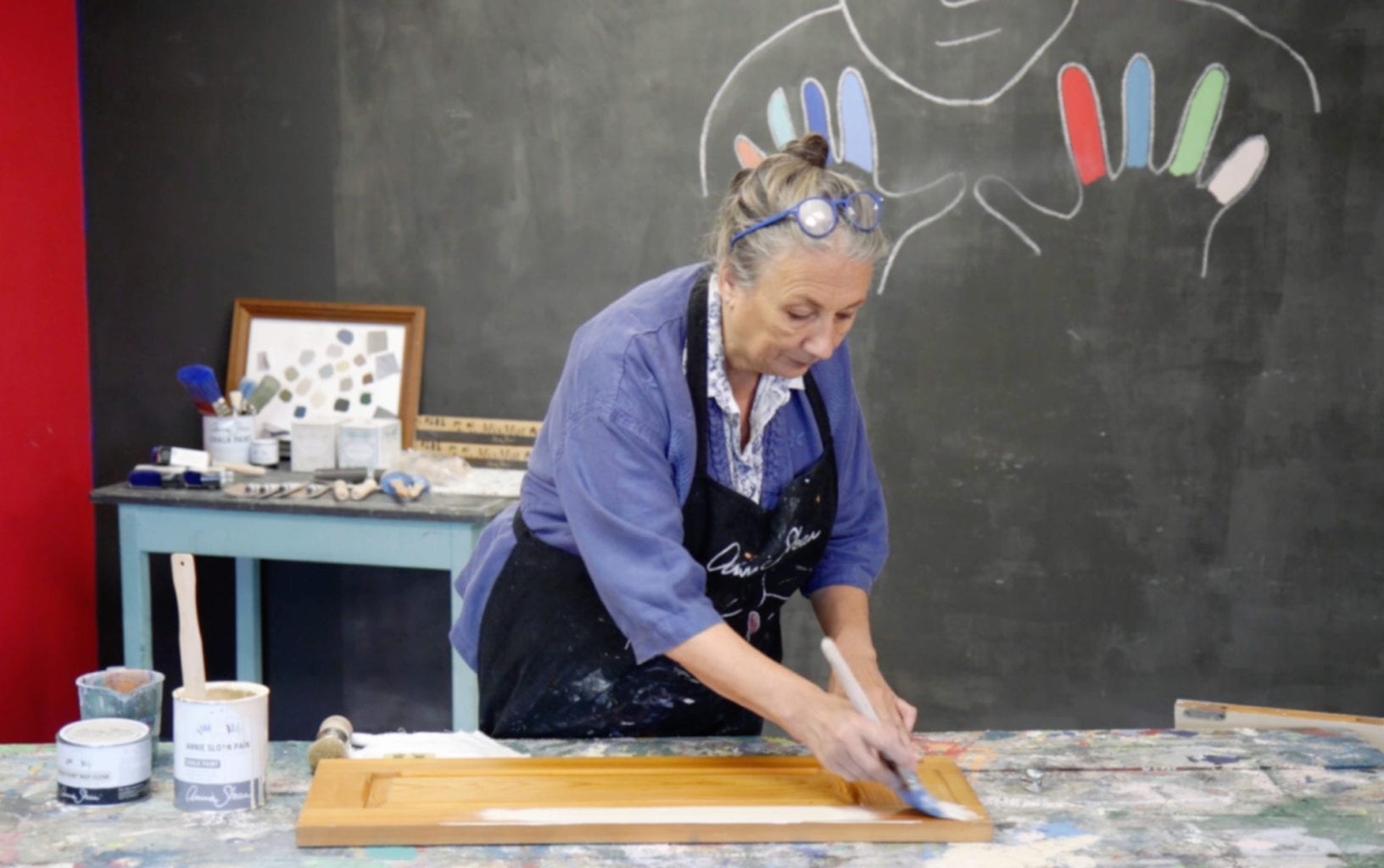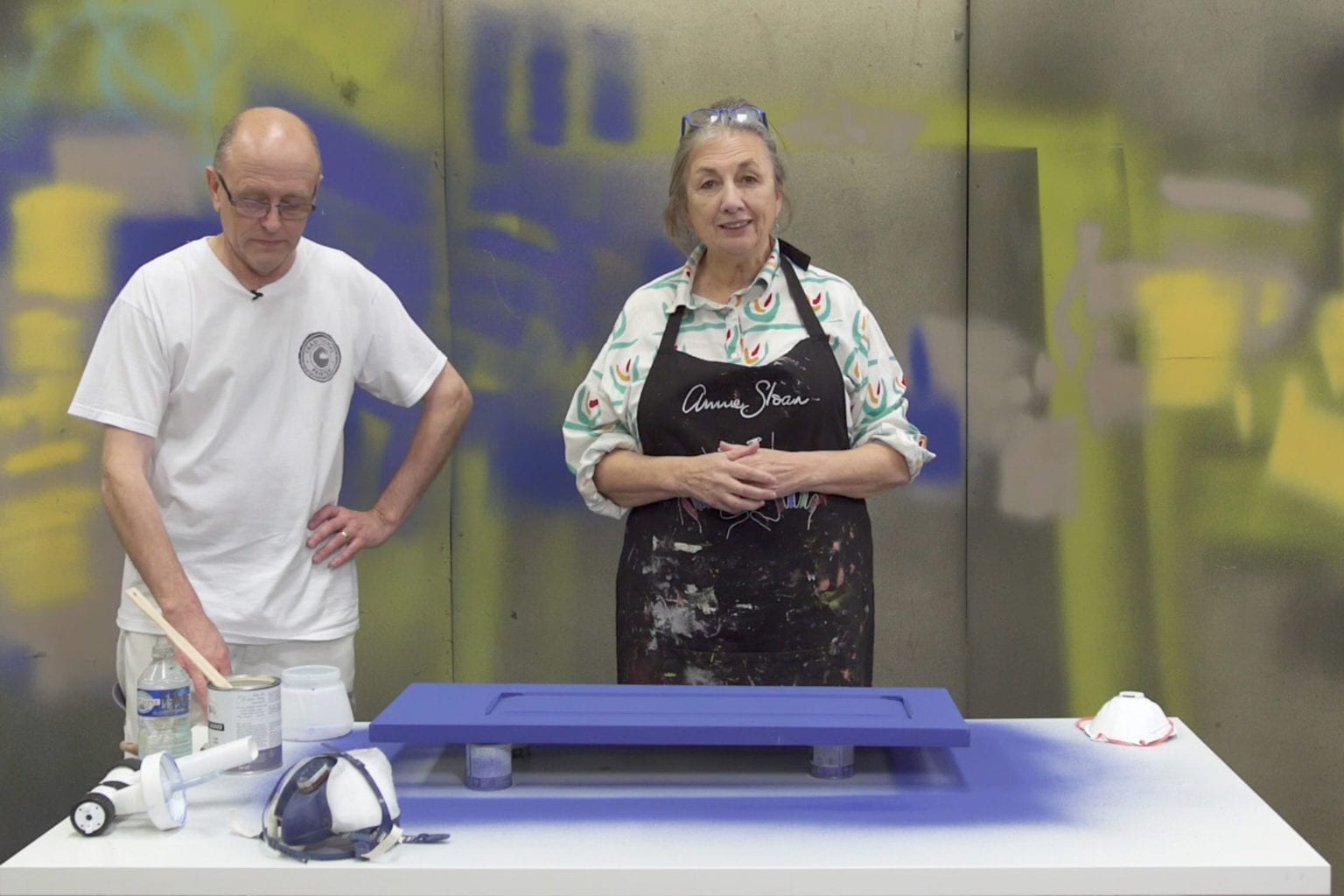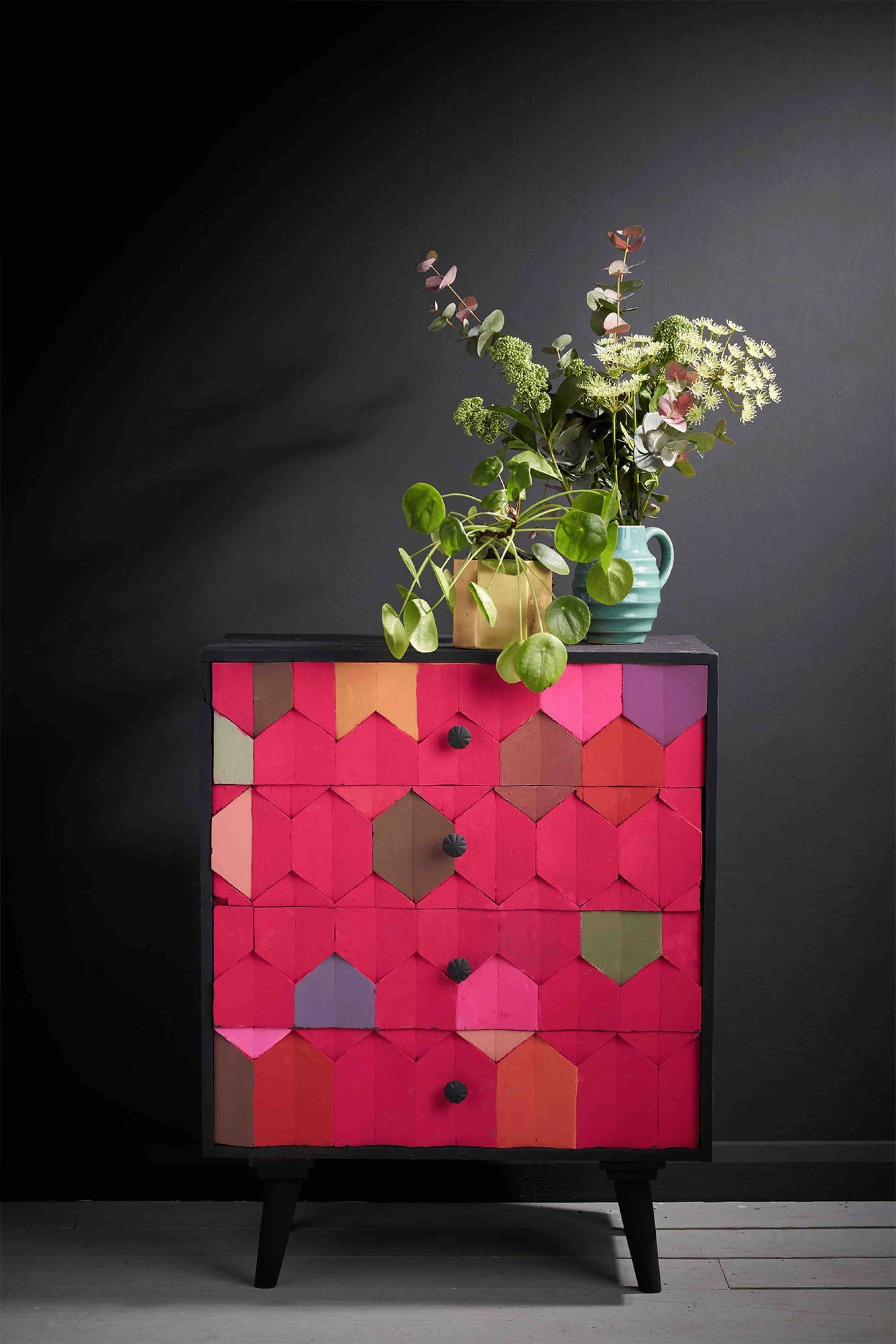Poniższy instruktaż tłumaczy to obszernie i szczegółowo. Omówiliśmy temat tak dokładnie, jak to możliwe, aby każdy uzyskał potrzebne informacje i jak najlepsze rezultaty. Doradzamy najpierw obejrzeć film, a następnie przeczytać instruktaż, aby ostatecznie wyjaśnić wszelkie wątpliwości.
Będziesz potrzebować:
• Farbę Chalk Paint™
• Wodę
• Pistolet malarski (Tutaj Annie stosuje pistolet malarski typu HVLP (duża objętość, niskociśnieniowy) marki Wagner 2370386 Studio Home Décor Sprayer do malowania ścian wewnętrznych. W Polsce można znaleźć pistolet malarski typu Wagner w590 lub w890.)
• Maskę ochronną do twarzy
Na czym to polega?
Pistolet natryskowy działa poprzez dołączenie farby do powietrza pod ciśnieniem. Farba jest rozpylana na małe cząsteczki, które są natryskiwane na powierzchnię.
Jest to szybki i skuteczny sposób na malowanie dużych powierzchni, na przykład szafek kuchennych, ale wymaga zaplanowania i przygotowania. Jeśli jesteś osobą początkującą, zalecamy najpierw malowanie farbą Chalk Paint™.
Po pierwsze, należy nalać farbę do zbiornika pistoletu. Pistolet jest podłączony do węża powietrznego i turbiny, która dostarcza strumień powietrza do natryskiwania farby (wszystkie te części stanowią jeden komplet przy zakupie). Turbina wypycha powietrze przez przednią część pistoletu i rozpyla farbę, rozbijając ją na małe cząstki. Sprężone powietrze w dyszy, łączącej zbiornik farby z pistoletem wywiera nacisk na farbę, pompując ją w górę dyszy, a po pociągnięciu za spust, farba spotyka się z powietrzem i jest rozpylana na powierzchnię.
Jak malować natryskowo farbą Chalk Paint™
1. Nalej farbę Chalk Paint™ do zbiornika pistoletu, mniej więcej do połowy.
2. Zacznij dodawać bardzo małe porcje wody, dokładnie mieszając, aby upewnić się, że farba i woda są całkowicie połączone. Ważne, aby nie rozcieńczać farby zbyt szybko.
Przed malowaniem natryskowym farbę Chalk Paint™ należy rozcieńczyć. Jedną z największych zalet farby Chalk Paint™ są możliwości dostosowania jej do wymagań: dodawanie wody w celu jej rozrzedzenia; odparowanie wody dla jej zagęszczenia (wystarczy zdjąć pokrywkę z puszki z farbą na jakiś czas); mieszanie z innymi kolorami w celu uzyskania idealnego odcienia.
Farba Chalk Paint™ prosto z puszki jest zbyt gęsta do malowania natryskowego. Sposobem oceny jej gęstości jest nabranie farby na pewną wysokość i obserwowanie, jak ścieka ona z powrotem do puszki. Jeśli pozostawia ona na pomalowanej powierzchni trójwymiarowy ślad, wyglądający jak smużki, oznacza to, że jest zbyt gęsta.
Nie ma tu dokładnej miary, wszystko zależy od gęstości oryginalnej farby! A to zależy od wielu czynników, głównie od klimatu w twoim kraju.
Gdy nabierzesz farbę i nie będzie ona pozostawiała śladów na mieszadełku, jest to właściwa konsystencja i farba jest gotowa do nakładania. Jeśli podczas natryskiwania farba jest zbyt gęsta, to będzie się nierównomiernie rozpryskiwać.
3. Kiedy farba będzie wymieszana, czas przygotować pistolet. Najpierw należy skierować dyszę z farbą w dół, gdy będziesz malować natryskowo. Grawitacja spowoduje, że farba opadnie na dno zbiornika, co będzie się zmieniać w zależności od kąta, pod którym będziesz rozpylać farbę. Więc jeśli malujesz natryskowo z góry, jak Annie i Ron na tym filmie, musisz także skierować wylot dyszy na dół. Jeśli malujesz natryskowo od dołu, musisz skierować wylot dyszy w górę, tak aby zawsze była zanurzona w farbie.
4. Następnie przymocuj zbiornik do pistoletu. Najłatwiej jest to zrobić na stole, gdy zbiornik jest pełen farby i jest mniej miejsca na jej rozlanie! Upewnij się, że zbiornik jest szczelnie dokręcony.
5. Podłącz wąż turbiny do pistoletu.
6. Zmień kąt ustawienia nakładki dyszy, dostosowując ją do kierunku natryskiwania. Jeśli będziesz natryskiwać farbę z lewej strony do prawej, stożki na nakładce muszą być ustawione poziomo. Jeśli będziesz natryskiwać farbę z góry na dół, stożki na nakładce muszą być ustawione pionowo. Jeśli postąpisz odwrotnie, na malowanej powierzchni nagromadzi się farba. Jeśli potrzebujesz nanosić cieńszą warstwę, możesz ustawić nakładkę w kierunku po przekątnej.
Bardzo ważne jest noszenie maski, chroniącej drogi oddechowe, przez cały czas malowania farbą. Jeśli nie używasz maski, unoszące się w powietrzu cząsteczki farby mogą powodować dolegliwości dróg oddechowych w przypadku ich wdychania.
7. Zalecamy najpierw wypróbowanie farby przed bezpośrednim nałożeniem jej na malowaną powierzchnię. Stosując ustawienie nr 2 nanieś farbę na powierzchnię testową; tutaj Ron wykorzystał ścianę w studio Annie. W ten sposób sprawdzisz, czy konsystencja farby jest właściwa i czy pistolet działa zgodnie z oczekiwaniami.
Pistolet, którego używają Ron i Annie jest pistoletem do pracy ciągłej; nie ma tu regulacji strumienia powietrza, jest tylko regulacja ilości podawanej farby. Oznacza to, że ilość przepływającego przez niego powietrza jest stała i nie zmienia się. Ilość farby przepływającej przez pistolet jest tym, co wpływa na szybkość jej natryskiwania. Na tym pistolecie znajduje się nakładka, oznaczona numerami, która zmienia natężenie przepływu farby. Nakładka pozwala na mocniejsze pociągnięcie spustu w celu zwiększenia ilości farby w dyszy. W przypadku farby Chalk Paint™, Ron stosuje ustawienie nr 2.
8. Następnie zacznij nakładać farbę na mebel. Zacznij od krawędzi i bardziej skomplikowanych elementów mebla. Następnie nakładaj farbę liniowo wzdłuż mebla, w uporządkowany sposób. Ważne jest nakładanie jej do połowy każdej poprzedniej linii, aby zapewnić równe pokrycie całej powierzchni. Stosuj konsekwentnie tę samą metodę malowania, aby wykończenie było równe; farba musi być nakładana w ten sam sposób, w przeciwnym razie będzie widać pominięte lub suche obszary.
9. Nałóż dwie warstwy farby, aby upewnić się, że żaden obszar nie został pominięty. Przy nakładaniu drugiej warstwy są dwie możliwości. Możesz malować bezpośrednio po nałożeniu pierwszej warstwy, zanim farba zacznie wysychać. Albo możesz odczekać około godziny (w zależności od lokalnych warunków pracy może to być dłużej) przed nałożeniem drugiej warstwy. Jeśli nie nałożysz drugiej warstwy natychmiast, konieczne będzie odczekanie całej godziny, ponieważ już po 2 minutach malowana powierzchnia zacznie wysychać.
10. Drugą warstwę należy nakładać w taki sam sposób jak pierwszą.
11. Pozostaw szafkę do wyschnięcia w miejscu, w którym nie trzeba będzie jej przesuwać, ponieważ każdy kontakt z suchą farbą spowoduje jej przebarwienie.
12. Kiedy farba całkowicie wyschnie, nałóż na nią wosk lub lakier Chalk Paint™ Lacquer. Wosk nakładaj pędzlem, natomiast lakier pędzlem, wałkiem lub pistoletem natryskowym. Kliknij tutaj aby obejrzeć jak Annie i Ron demonstrują wykończenie szafki nakładając natryskowo lakier Chalk Paint™ Lacquer.


